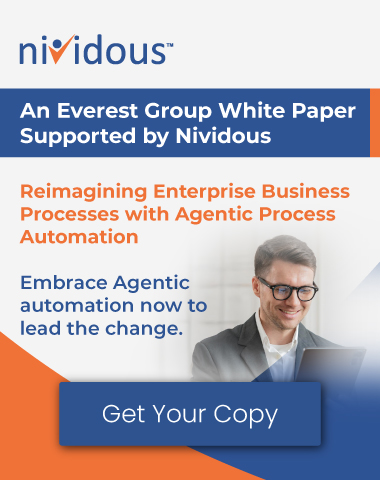The way we work is undergoing a transformation. Automation is no longer limited to reducing headcount or processing more transactions per hour. It’s reshaping how organizations think about problem-solving, planning, and people. Leading this evolution is a powerful new class of intelligence: agentic AI.
While traditional automation focuses on efficiency, agentic AI introduces purpose-driven automation. These systems understand goals, take initiative, make decisions, and adapt continuously. They represent a shift from passive execution to proactive contribution, bringing organizations closer to intelligent, outcome-driven operations.
In this article, we explore agentic AI, how it differs from other forms of AI, and why it’s quickly becoming essential to the future of work.
A New Chapter in Intelligent Automation
Agentic AI is a form of artificial intelligence that acts autonomously in pursuit of defined goals. These systems can reason through complex scenarios, divide objectives into smaller tasks, adapt to real-time variables, and continuously learn from experience.
Unlike traditional AI, which is task-triggered and largely reactive, agentic AI responds to changing environments with initiative. While generative AI produces content based on prompts, agentic AI agents can make decisions, take actions, and even adjust their course based on feedback loops without waiting for human commands.
Agentic AI frameworks integrate planning engines, contextual memory, and task decomposition capabilities to support dynamic, judgment-based automation. This allows them to interpret business context, prioritize conflicting goals, and coordinate across multiple systems. They do more than simply streamline workflows; they lead them.
Moving From Passive Tools to Purposeful Agents
Legacy automation tools like RPA and traditional AI engines are reactive. They follow rules, scripts, or workflows. They’re reliable but limited. When faced with exceptions, ambiguity, or change, they falter.
Agentic AI is different.
Agentic AI systems do the following:
- Interpret intent and evaluate the best next action
- Deconstruct loosely defined problems into manageable steps
- Adapt workflows based on evolving data or business logic
- Collaborate across siloed applications, teams, and departments
- Learn from feedback loops to improve future performance
Businesses can now begin automating decision-making, judgment calls, and dynamic workflows, which previously demanded constant human oversight.
An AI agent working in procurement can track inventory levels, forecast demand, negotiate pricing terms, and trigger reorder processes across multiple vendors. This is driven by broader goals and shifting variables, not fixed triggers.
Rethinking Workflows With Agentic AI Frameworks
To make Agentic AI effective, businesses need workflows that support autonomy. Agentic AI frameworks are structured to enable:
- Orchestration of full workflows from intake to completion
- Processing of unstructured inputs like PDFs, audio, or emails
- Management of business logic alongside real-time variables
- Dynamic decision-making that reflects evolving priorities
- Actions that align with enterprise-level outcomes
In a support environment, an agentic AI system can scan incoming tickets, classify urgency, suggest responses, and route tasks, all without pausing for human input. These frameworks enable organizations to scale decision-making capabilities across departments, systems, and outcomes.
When paired with domain-specific knowledge and compliance logic, they enhance efficiency while also helping reduce risk.
Agentic AI is already active within the Nividous unified automation platform. Our solution merges agentic AI, generative AI, RPA, and low-code design to deliver intelligent automation that aligns with your goals, adapts to your environment, and accelerates your operations.
How Agentic AI Is Transforming Human Work
Agentic AI reshapes more than workflows. It’s redefining how human contributions are valued, where teams focus their energy, and how organizations design their operations for long-term success. This evolution signals a future where people and AI-driven agents collaborate to achieve greater impact with less manual effort.
From Step-by-Step Execution to Strategic Oversight
Traditional workflows depend on humans to track progress, troubleshoot issues, and manually advance each step. Agentic AI transfers those responsibilities to intelligent agents acting proactively based on predefined goals and real-time data. This frees employees from constant monitoring and enables them to lead with intention rather than react out of necessity.
This shifts employee roles from tactical executors to strategic supervisors. Instead of manually processing approvals or pulling reports, they define success criteria, set parameters, and intervene only when human judgment is needed. This unlocks more creative, complex, and strategic contributions and positions people to guide work without having to carry it out step by step.
New Roles and Skills for an Augmented Workforce
The rise of autonomous agents creates demand for new roles across industries that blend business context with technical coordination. Titles like AI Workflow Designer, Agent Operations Manager, and Digital Ethics Officer reflect this new hybrid workforce. These professionals design, monitor, and optimize the interaction between digital agents and the people they support.
To prepare for this shift, organizations must equip employees with a new skill set: systems thinking, automation governance, and real-time decision support. Fluency in interpreting AI outputs, designing exception paths, and understanding feedback loops will become core competencies on tomorrow’s most agile teams.
Fully Connected, Outcome-Oriented Workflows
Most organizations operate in fragmented environments, where work passes through disconnected tools, teams, and handoffs. Agentic AI closes these gaps by orchestrating workflows that respond in real time to signals, constraints, and shifting objectives. A single agent can monitor performance and escalate issues across teams without manual intervention.
This shift removes friction from critical processes like invoice management, onboarding, or order fulfillment. Instead of tracking to-do lists, employees manage outcomes. Departments like finance, HR, and operations benefit from consistent, compliant, data-driven workflows that require minimal oversight and deliver measurable results.
Ready to lead the next wave of intelligent automation?
Download Everest Group’s Agentic Process Automation white paper, supported by Nividous, and discover how leading enterprises are using AI agents to move beyond traditional automation — boosting both efficiency and innovation.
Where Agentic AI Software Is Already Having an Impact
Agentic AI software is actively generating value in complex, fast-paced industries.
In healthcare, agents analyze patient records, recommend diagnostic tests, and manage approvals for follow-up care while aligning with compliance requirements and privacy protocols.
In finance, autonomous agents detect anomalies in transaction data, reconcile discrepancies, and generate alerts for outliers. These capabilities speed up month-end processes and improve audit readiness.
In logistics, agentic AI uses real-time data to reassign drivers, reroute packages, and update shipping schedules. This delivers operational agility without requiring a team of dispatchers.
These aren’t proofs of concept. They’re active deployments that reduce error rates and accelerate time to value.
How to Identify the Right Processes for Agentic AI
Not every workflow is a good candidate for Agentic AI, and that’s a good thing. To avoid wasting effort on hype-driven deployments, leaders should ask:
- Is the process outcome-based? Agentic AI excels where the end goal is clear, even if the steps to get there aren’t.
- Do inputs change frequently? Processes that rely on real-time signals, like customer behavior or supply shifts, benefit from adaptability.
- Are humans making repeated judgment calls? If a process relies on pattern recognition or exception handling, Agentic AI can reduce variability and improve scale.
- Is the current workflow siloed or slow? Cross-functional processes are ideal, especially when coordination lags performance.
Start with high-volume, repetitive workflows where autonomy delivers measurable ROI, and expand from there.
What to Consider When Adopting Agentic AI
Implementing agentic AI is a long-term strategic shift, not a plug-and-play tool. It requires a deliberate approach to integration, governance, and user adoption across every layer of the organization. Businesses must ensure that agentic AI performs tasks responsibly, securely, and with long-term success in mind.
Pilot programs are essential. Start small by targeting high-volume, rules-based processes that are time-consuming but low-risk. Measure improvements in speed, accuracy, and ROI. Then expand into more complex processes once confidence is built.
Governance
Define clear decision boundaries, escalation triggers, and conditions for human-in-the-loop intervention. These protocols ensure that agentic AI operates within the limits of business rules, compliance policies, and ethical considerations, especially in high-risk or regulated environments.
Transparency
Maintain complete visibility into agent actions. Every decision made by an AI agent should be traceable and auditable, particularly in sectors like finance, healthcare, and insurance. Logs, dashboards, and reporting structures should offer real-time insights into AI behavior.
Accountability
Assign clear ownership for AI oversight, monitoring, and performance management. Define roles for auditing, safety checks, periodic testing, and continuous improvement to prevent automation drift and maintain trust in the system’s decisions.
Integration
Agentic AI should seamlessly connect with your existing tech stack. Ensure compatibility with ERP, CRM, document management, communication tools, and workflow systems. Native or API-based integrations reduce friction and speed up deployment.
Change Management
Prepare your workforce for a new dynamic. Introduce training, communication, and support resources to help employees transition into more strategic roles. Address concerns early and demonstrate how agentic AI improves human value and productivity.
Nividous helps customers build a strong foundation with expert implementation support, security-conscious infrastructure, and integrated governance features.
Nividous Offers Intelligence That Moves With You
Agentic AI represents a smarter, more forward-thinking approach to automation. It gives businesses the tools to move faster, work more intelligently, and scale without friction.
Nividous brings these possibilities to life through a unified platform that integrates agentic AI, generative AI, RPA, and low-code automation. This system is built natively with security and performance at its core.
Whether you’re optimizing healthcare workflows, accelerating claims, or improving finance operations, Nividous helps you get there faster, with less risk and greater ROI.
With an industry-leading customer retention rate, our team knows what it takes to deliver lasting value.
Reach out to start your automation journey and discover what’s next with Nividous.





